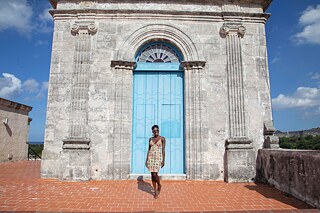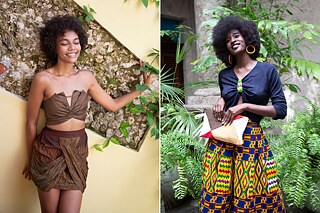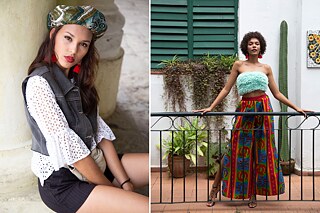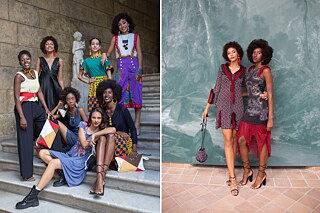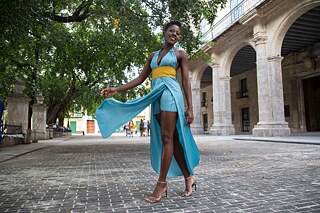Upcycling Cuba: Turning Scarcity Into Style

Fashion from Havana was glamourous, colourful and a big hit with celebrities from the USA and Caribbean in the fifties – until the Cuban revolution turned the fashion industry into an economy of scarcity. Cuba’s designers are now turning need into something creative.
Madelaine Munoa brings curtains onto the catwalk: the young Cuban designer produces summer wear made out of various materials including recycled curtains. Fashion designers Daniela Hernández and Aslin Asencio create new patterns using leather and fabric scraps that they’ve taken apart and sewn back together. Cuba’s creatives are upcycling pioneers – even if hardly anyone knows about it yet.
When most people hear the word Cuba, they don’t tend to associate it with ecology and resource processing, nor with a mecca for alternative fashion production. They generally think in clichés: glossy vintage cars, music in the style of the Buena Vista Social Club, or Fidel Castro puffing on a cigar. But also poverty and shortages, and socialist politics, which still characterise daily life and interaction with the West today.
But the Cuban capital, Havana, is a pioneer when it comes to upcycling. This is when rubbish or end-of-life products are reused to create something new – inevitably. The thing is, there is scarcity in all sectors: industry, medicine, technology and of course consumer goods. They do flog cheap clothing from Asia on a mass scale in discount stores here too. But Cubans are not familiar with the idea of discarding it after a year. “In Cuba it has been and still is customary to pass clothing on to other family members, altering it as required and to reflect current fashions,” writes Michael M. Thoss, former head of the Goethe-Institut liaison office in Havana, in his book Upcycling Havana. Re-using in this context doesn’t mean wearing worn-out jeans and faded pullovers – it’s all about giving fabric a second, new life.
Not a Single Square Metre of Fabric Is Thrown Away
Trends such as sustainability, circular economy models and slow fashion characterise debates in the West. Second-hand shops have become established worldwide and reach people who want an eco-friendlier lifestyle. The fashion sector is also moving away from disposable consumption and instead favouring upcycling. Established fashion brands like Chanel or Louis Vuitton, retail chains such as H&M, or sportswear manufacturers like Adidas are increasingly promoting fashion collections made from recycled material.
That’s part of life for Cubans. Up-and-coming labels are taking international cities by storm and showing that the old re-use model is far more than just the consequence of an economy of scarcity. This is possible because fashion design and tailoring are among the few professions in Cuba that are not state-controlled. So theoretically the designers can access the market freely. In practical terms however, it isn’t quite that straightforward, says Michael M. Thoss: “Because it’s difficult to open a fashion boutique officially, Cuban fashion designers make clothes in their front room and sell them abroad on the internet.” Opening a shop usually takes too long because of all the bureaucracy, and also costs a huge amount of money. For this reason Cubans – like small business owners worldwide – use the internet to sell things. Whilst they are not able to reach markets like the USA or Europe directly because of the US embargo, a simple export trick allows them to circumvent this: “Friends and family take individual items with them in their suitcases on holidays abroad to Europe or the USA, and then sell them directly from there.”
The government doesn’t have a problem with that, “quite the opposite, they are pleased to have currency coming into the country,” according to Thoss. Where there isn’t much, people get creative: “96 per cent of jobs are in the state sector, people earn 50 dollars a month, which is difficult to live on because the prices of imported everyday and consumer products are constantly high, as is inflation.” As a result, everything in Cuba has a second life, he continues. “Nothing is discarded here. Not a single square metre of fabric is thrown away, no matter what materials the garments are made of.”
That’s reflected equally clearly in the work of designers Alain Marzan and Camila Aguilar, which is based on a mix of denim and tropical motifs. The two designers were involved in the HabanaTrapo project: in 2022 TU Berlin joined forces with Professor Josephine Barbe and the Goethe-Institut, and grouped 13 Cuban designers together with the aim of “reducing environmentally harmful by-products and at the same time making garments that are high quality and durable.” The initiative also stresses that: “upcycling is more than just recycling, it’s ethical management of our limited natural resources.”
“My workshops on sustainable fashion are the response to a fashion industry that has got completely out of hand, lost its sense of proportion, which is based on a colossal waste of resources,” writes Josephine Barbe. “That’s why my workshops focus on designing clothes using methods that combat this overexploitation and are founded on the principle of upcycling.”
Diverse Fashion Creations: Feminine, Queer and Afro-Cuban
HabanaTrapo showcases the diversity of society and the Cuban fashion market. “There were professors from fashion institutes and ordinary tailors from the suburbs in this project,” relates Michael M. Thoss. Diverse output has emerged from the heterogeneous group: queer feminist fashion, for example. Designer Dora Jorrin channels her own family experiences into her creations. She has teamed up with her daughter, a transsexual model, and they create queer fashion perspectives as a designer/model duo. The Afro-Cuban culture is also strongly reflected in the garments they design. Their patterns and styles feature African motifs and cuts, while models wear creative Afros.
Because fabrics are in short supply, Cuba could even become an experiment lab for alternative fibres in future: hemp, bamboo, which grows rapidly and prolifically in Cuba, or algae, with which the beaches are inundated. These alternative-fibre fabrics might also be of interest to the traditional fashion industry outside the island.
“The conventional textile industry is one of the world’s biggest environmental polluters, and is responsible for a considerable proportion of global CO2 emissions,” write Michael M. Thoss. But he points out that using local resources is important too, in order to keep the designers in the country. In the last eighteen months, Cuba has lost almost four per cent of its population, mainly “young, dynamic people”, who are a loss to the economy and development of the country. Together with his co-editor Boris Antonio Perez Vasquez, he hopes to use the project to promote private initiatives rather than the state-controlled economy, and encourage Cuban fashion designers to establish their own brands: “We want to show people that there are alternative business models in Cuba, and that there is a huge creative potential – so plenty of reason to stay in the country.”
The “HavanaTrapo” upcycling project in Cuba could be realized thanks to special funding from the German Federal Foreign Office.
“Upcycling Havana”
The volume “Upcycling Havana” was published by Hirmer Verlag in 2024, edited by Boris Perez Vasquez and Michael M. Thoss, 80 pages, in English under the motto: “Havana for trendsetters: the innovative fashion, art and architecture travel guide”. Along with the city’s tourist hotspots, this guidebook leads you to the latest workshops of sustainable fashion designers and selected “upcycled” architectural highlights as well as trendy bars and shops which enable you to experience Havana in a completely new way as it undergoes its current transformation into a modern city. “Upcycling Havana” at Hirmer Verlag
